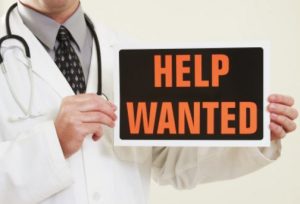
January 11th, 2021 by Dr. Val Jones in Health Policy, Opinion
Tags: AMA, COVID-19, fellowship, NP, NPP, Over specialization, PA, Physician Burnout, physician retraining, Physician Shortage, workforce solution
3 Comments »
 Because science is advancing our understanding of medicine at an exponential rate, physicians and surgeons have been turning to subspecialization as a means to narrow their required domains of expertise. “Carving out a niche” makes sense in a profession where new research is being published at a rate of two million articles per year. Just filtering the signal from the noise can be a full time job.
Because science is advancing our understanding of medicine at an exponential rate, physicians and surgeons have been turning to subspecialization as a means to narrow their required domains of expertise. “Carving out a niche” makes sense in a profession where new research is being published at a rate of two million articles per year. Just filtering the signal from the noise can be a full time job.
However, the consequences of narrowing one’s expertise is that you lose flexibility. For example, an orthopedist who has subspecialized in the surgical management of the shoulder joint doesn’t keep her skills sharp in knee replacement surgery or other general surgical procedures that she once performed. Neurologists who focus on movement disorders become comfortable with a small subset of diseases such as Parkinson’s, but then close their doors to patients with migraines or strokes.
The continued march towards ultra-subspecialization has been a boon in urban and academic centers, but has left spotty expertise in surrounding areas and small towns. And now, the COVID-19 pandemic has unmasked the biggest downside of niche medicine: a hardening of the categories that prevents many physicians from being able to help in times of crisis. Retina specialists, plastic surgeons, rheumatologists, and radiation oncologists (to name just a few) may want to help emergency medicine physicians (EM), internists (IM), and intensivists (CCM) expand their reach as COVID cases surge and hospitals become overwhelmed. But what are they to do? They are not trained to manage airways, place central lines, or monitor renal function, and legitimately fear legal repercussions should they attempt to do so.
Medicine is fundamentally based upon apprentice-style learning – this is why we undergo years of residency training – to stand shoulder-to-shoulder with more senior experts and learn their craft under close supervision. Upon graduation from medical school, physicians are deemed ineligible to treat patients until they have practical experience under their belts. The old adage: “see one, do one, teach one” is the bedrock of how we train. So now, there needs to be a pathway available for those who have completed residency to re-train to meet the demands of this crisis and others.
Perhaps it’s a radical idea to consider pairing subspecialist physicians with current frontline COVID-19 doctors – but turfing patients to “non physician practitioners” or NPPs when access is limited to an emergency medicine specialist, internist, or intensivist, seems to be the current plan. I believe that medical school and internship are a solid foundation for COVID management (common to all physicians), and that given a designated EM, IM, or CCM mentor, the willing subspecialists will be able to follow protocols and take on new challenges rapidly and with excellence. I hope that the government will issue more detailed “good Samaritan” type laws to protect mentors and their subspecialty partners from frivolous law suits in times of COVID (those in place are for volunteer positions only), and that the house of medicine, led by the AMA and other sub-specialty organizations, will pave the way for rapid cross-disciplinary instruction and certification.
Going forward, there should be opportunities for post-residency, mid-career physicians to complete fellowship programs outside of their sub-specialty’s usual offerings. An ophthalmologist should have the ability to spend a year studying pulmonary medicine, for example, if they want to moonlight with an ICU physician in the future. In our current system, it is very difficult to obtain a fellowship after significant time has elapsed since one’s residency training. While there are a few “re-entry programs” for physicians who haven’t practiced clinical medicine for years, there is no path established for those who simply wish to switch specialties or assist outside of their specialty in a time of crisis.
I am not arguing that a fellowship should be considered equivalent to a residency program. We may need to create a new type of physician certification that allows fellowship-trained physicians from unrelated residency programs to operate under the license of an agreeable mentor/sponsor already established in the field by virtue of medical school and residency training. This would open up employment opportunities for over-specialized physicians, while not threatening those who are residency-trained in the field. In essence, this would allow physicians to operate in the way that NPPs have been for decades, and get subspecialty physicians off the bench and into the fight against COVID and perhaps into underserved areas more effectively as well.
For those subspecialists who have become disillusioned with their field, but still enjoy medicine or surgery – their talent could be retained if there were a path to re-training. An estimated 20% of physicians would change their specialty if they could. Currently, physicians have few clinical options if they no longer wish to practice in the field in which they completed a residency. I suspect that sweeping physician burnout rates (highest among mid-career physicians) could be improved by providing opportunities for “reimagining” themselves – and course-correcting to rekindle the scientific and clinical passion that led them to apply to medical school in the first place.
This would require some mental and regulatory flexibility – which could be a good side effect of the otherwise dreadful COVID pandemic.
July 3rd, 2017 by Dr. Val Jones in Health Policy, Opinion
Tags: Administrative Burden, Coverage Is Not Care, Health Insurance Roadblocks, Pre-Authorization, Underinsured
6 Comments »
 American healthcare reform debates are focused on strategies to provide “access” to medical services for all. Lack of insurance (or under-insurance) seems to be the primary focus, as it is falsely assumed that coverage provides access. Unfortunately, the situation is far more complicated.
American healthcare reform debates are focused on strategies to provide “access” to medical services for all. Lack of insurance (or under-insurance) seems to be the primary focus, as it is falsely assumed that coverage provides access. Unfortunately, the situation is far more complicated.
Once a person has health insurance, there is no guarantee that they will receive the medical services that they need. Not because their plan is insufficiently robust, but because the roadblocks for approval of services (provided in the plans) are so onerous that those providing the service often give up before they receive insurance authorization. In my experience, whether or not the patient gets the service, test or procedure that they require often depends on the individual will and determination of their physician. And that’s something we need to talk about.
Take for example, admission to an inpatient rehabilitation facility. Brain-injured patients aren’t much different than those with broken bones. We all know that bones need to be set (or surgically repaired) right away so that they will heal correctly. The brain is very similar – once injured, it needs to be rehabilitated in an intensive, multi-disciplinary environment at the earliest chance for it to achieve its best healing. Nevertheless, insurance companies regularly deny brain injury rehab to patients in the critical healing time frame. They will approve nursing home care for them, but not the intensive cognitive rehabilitation that they need, unless the rehab physician fights an epic authorization battle that can take 10 days or more to overturn the denial of services! Imagine if your orthopedist had to beg, lobby, and testify for 10 days to fix your broken hip (while the insurance company simply approved you go to a nursing home)? Would he or she be willing to do this? What would happen to your hip in the mean time?
The “prior authorization” process for imaging studies and non-formulary medications is also designed to wear down the providers and passively deny services to patients, thereby saving costs for the insurers. Patients don’t realize that getting an MRI might mean an hour of automated phone system “hell” for their physician, waiting to speak to an insurance customer service rep with an algorithm that determines whether or not the patient is eligible for the service – unrelated to the physician’s judgment or the particulars of the patient case. In the average American primary care practice, an estimated 20 hours per week is spent by physician and staff, attempting to secure insurance approval for necessary tests and medications. Will your physician have the endurance to prevail? That might be the difference in diagnosing your cancer early or not.
“Oh,” but the insurance companies say, “we had to put these bumps in the road to prevent over-testing and abuse of the system.” I agree that there are some bad actors who should be identified and stopped. Think of the phony durable medical equipment providers, bilking Medicare and private insurers by prescribing unnecessary and expensive wheelchairs, scooters, and other devices. These bad apples are rare, but because of them – all the “good guys” are being hen-pecked to death just to get a walker for a patient with multiple sclerosis.
Unfortunately, there is no incentive for the private insurers to lift the pre-authorization burdens from the “good guy” physicians. Therefore, this will probably have to be achieved through legislation. With big data, it should be fairly easy to identify extreme provider outliers – and have their practices reviewed. For the rest of us, our pattern of judicious prescription of tests, services, and procedures should win us a break from the daily grind of begging, wheedling, and cajoling payers to allow us to get our individual patients what they need, every single time we order something. Until this freedom to practice medicine is achieved, true access to healthcare will not simply be a matter of having health insurance, it will be whether or not your physician has the will to fight for your needs. A “good doctor” has to be more than an excellent diagnostician these days – she must be a savvy, health insurance regulatory navigator and relentless patient advocate. Keep that in mind as you choose your next physician!
June 5th, 2017 by Dr. Val Jones in Health Tips, Opinion
Tags: Best Locum Tenens, gig economy, healthcare workforce, Largest Locum Tenens, Locum Tenens, Locum Tenens Ratings, Quality Locum Tenens, Traveling Physician
4 Comments »
 I receive a significant amount of email in response to my blog posts about locum tenens work. Curious colleagues (from surgeons to internists and emergency medicine physicians) ask for insider insight into this “mysterious business” of being a part-time or traveling physician. I am always happy to respond individually, but suddenly realized that I should probably post these conversations on my blog so that all can benefit.
I receive a significant amount of email in response to my blog posts about locum tenens work. Curious colleagues (from surgeons to internists and emergency medicine physicians) ask for insider insight into this “mysterious business” of being a part-time or traveling physician. I am always happy to respond individually, but suddenly realized that I should probably post these conversations on my blog so that all can benefit.
The most common question I receive is: How do the agencies compare with one another? Followed closely by: Where should I start? There is no online rating system for this industry, and so grade-focused physicians (taught to value performance ratings) feel at a loss as to where to begin. One day I hope we’ll have a locum tenens quality website, but for now I can offer you my N=1, “case study” experience.
I’ve been doing hospital-based, locum tenens work for 6 years in the field of inpatient rehabilitation medicine. I have accepted 14 assignments through the following agencies:
CompHealth, Weatherby Healthcare, Jackson & Coker, Medical Doctor Associates, LocumTenens.com, and All Star Recruiting
I have had extensive conversations with recruiters at the following agencies, but have not ended up taking an assignment through them:
Staff Care, Delta, Onyx, Barton Associates, and Farr Health
I have summarized my experiences in this table:
| Agency Name |
Number of Assignments |
Quality of Client (Hospital or Employer) |
Quality of Recruiter(s) |
Salary Provided (percent of what I would consider standard) |
| Comp Health |
4 |
B,B,C,C |
A |
80-100% |
| Weatherby Healthcare |
3 |
A,B,C |
A |
85-100% |
| Jackson & Coker |
3 |
A,C,D |
C |
85% |
| Medical Doctor Associates* |
1 |
A+ |
A |
100% |
| LocumTenens.com* |
2 |
A,D |
B |
50-100% |
| All Star Recruiting* |
1 |
B- |
A |
150% |
| Self-Negotiated |
3 |
A,B,D |
N/A |
175% |
*These agencies use VMS systems.
These “data” are highly subjective, of course, but there are a few important points to be gleaned:
- Bad clients are hard to avoid. When I give a client a “D” rating, that means a hospital or employer that is so bad, you have concerns for your medical license or don’t feel ethically comfortable with what they are asking you to do. These are nightmare assignments and must be carefully avoided. I describe my experience with one of the “D’s” here. Big name agencies (and even I on my own) can be duped into accepting bad apple clients. Since it’s hard to know which ones are truly bad (even after a phone interview), I now only commit to a short (about 2 week) initial assignment and then extend once I feel comfortable with the match.
- There are good recruiters everywhere. Although the larger agencies pride themselves in outstanding customer service, the truth is that I have had great relationships with most recruiters at most agencies. From a physician perspective, the “customer experience” is fairly uniform.
- Vendor Management Systems (VMS) don’t create the race to the bottom I expected. The largest agencies are strongly against automated physician-client matching software (which is essentially what VMS does) and argue that they destroy the customer service experience for both hospitals and physicians. Although I am philosophically opposed to being listed on a hospital purchase order along with IV tubing and non-latex gloves, the truth is that such matching has brought me higher-paying assignments at good quality hospitals that do not hire locum tenens physicians outside of a VMS system. I see no reason to exclude agencies who use VMS, though there is a risk of being in a larger competitive pool for each individual assignment. This means that you may waste some time before being placed, but in the end if the pay is $150% of base, then its probably worth it.
- Boutique is not better in the locum tenens world. Unless you are in a specialty that is so small you require recruiters who can perform highly customized job matches, boutique agencies can be home to some of the most depressing assignments in America. Desperate clients who have not had success in filling positions through the (highly motivated) big agencies will turn to boutique ones, hoping that their sheer force of personality will cover for the flaws that make their hospital’s hiring difficult. I have learned to steer clear of the boutique charm offensive.
- You can make a higher salary if you find your own job. Agencies provide significant value to physicians. They do the hard work of locating and updating job assignments, assisting with credentialing and licensing paperwork, negotiating salary and overtime, providing professional liability insurance, and handling logistics (travel/lodging booking and re-booking). That being said, if you’re willing to do all that yourself, you can negotiate a much higher salary if you work directly with hospital HR.
- Will “gig economics” eventually bypass the current agency model? Online job-matching sites will probably take a big chunk of market share, but won’t “own” the space because they don’t provide the logistical, legal, and credentialing services that physicians enjoy from agencies. However, given that agency fees add about 40% costs to physician hiring, there is strong motivation to find alternative hiring strategies, and I suspect that Millennial physicians won’t mind doing extra work for higher pay. Websites like Nomad Health are suffering from limited user sign up (both on the client and worker side), but will likely reach a tipping point when a VC firm provides the marketing capital to raise sufficient awareness of the new hiring marketplace that bypasses recruiters and saves hospitals money. Until then, dipping your toes into the healthcare gig economy is easiest to do through an agency – and the big ones (CompHealth and their subsidiary Weatherby Healthcare have about 50% of the market share, followed by Jackson & Coker as the next largest) provide the largest number of options.
The bottom line is that part-time and short term physician assignments can prevent physician burnout and overwork. The pay is generally very good, and agencies can make the experience as painless as possible. Those who desire higher hourly rates can achieve them if they’re willing to take on more responsibility for paperwork and logistics. Whether this “do it yourself” movement is enhanced by online marketplaces, or good old fashioned cold-calling to find work – physicians hold the cards in this high demand sector. I suspect that more of us will be ready to play our cards in the locum tenens space in the upcoming years, because full time medical work (at the current pace) is, quite ironically, simply not healthy.
May 15th, 2017 by Dr. Val Jones in Opinion
Tags: Concierge Medicine, Direct Primary Care, gig economy, gigging, IT, Locum Tenens, Nomad Health, Physician Burnout, Physician Workforce, Tech
No Comments »
 The New Yorker recently featured a long essay about a popular new episodic work style sweeping America: the “gig economy.” The gig economy unbundles units of work previously tied to an employer or specific job. Online platforms serve as conveners to match task requests with those seeking to complete them. The New Yorker notes:
The New Yorker recently featured a long essay about a popular new episodic work style sweeping America: the “gig economy.” The gig economy unbundles units of work previously tied to an employer or specific job. Online platforms serve as conveners to match task requests with those seeking to complete them. The New Yorker notes:
TaskRabbit, which was founded in 2008, is one of several companies that, in the past few years, have collectively helped create a novel form of business. The model goes by many names—the sharing economy; the gig economy; the on-demand, peer, or platform economy—but the companies share certain premises. They typically have ratings-based marketplaces and in-app payment systems. They give workers the chance to earn money on their own schedules, rather than through professional accession. And they find toeholds in sclerotic industries. Beyond TaskRabbit, service platforms include Thumbtack, for professional projects; Postmates, for delivery; Handy, for housework; Dogvacay, for pets; and countless others. Home-sharing services, such as Airbnb and its upmarket cousin onefinestay, supplant hotels and agencies. Ride-hailing apps—Uber, Lyft, Juno—replace taxis. Some on-demand workers are part-timers seeking survival work, akin to the comedian who waits tables on the side. For growing numbers, though, gigging is not only a living but a life. Many observers see it as something more: the future of American work.
The pluses and minuses of this kind of work are fairly straight forward. On the positive side there is speed and convenience (both on the part of the worker, and the one who needs the work done). Rapid matching of task to worker occurs in an online environment that promotes competition and favors those with high ratings and a track record of success. There is flexibility for the worker – he or she can commit to as much or as little work as is convenient, and there is the opportunity for augmenting earnings as small, paying “gigs” can be added to already existing work. Variety provides challenge and interest.
On the negative side, choosing to do gig work full-time leaves the gigger without employee benefits (such as health insurance) and an insecurity of income stream. Without a large, trusted company as the agent for work, there are fewer guarantees of service (or protections) for both the hiring entity and the worker. With freedom comes insecurity. And then there’s the question about career advancement and long term economic effects of short-term work.
It seems to me that for most people outside of the healthcare marketplace, the gig economy works best as an income supplement, not replacement. In medicine, however, full time gigging may actually have more pros than cons.
In a system where fee-for-service healthcare is rapidly being replaced with bundled payments, shared responsibility, and accountable care, it is ironic that the workforce is moving in the opposite direction. Although initially physicians were driven to become hospital employees (instead of independent practitioners), now the pendulum is swinging in the gigging direction. Primary care is embracing the “direct pay” model, and more and more physicians are joining locum tenens agencies. I myself was an early adopter of both concierge medicine and locum tenens work.
Direct primary care is efficient – patients pay only for what they need (presumably from an HSA account), and there are incredible cost savings involved for providers, not having to code and bill insurance companies for services. As I’ve said previously, using health insurance for primary care is like having car insurance for windshield wipers. Expensive overkill.
As far as locum tenens is concerned, there is no better way to prevent burn out and overwork than to reclaim control of your work schedule. Short term work assignments may be accepted or declined at the physician’s convenience. You can travel as far and wide as you have interest (there are international locums assignments available too), and gain exposure to various practice styles and locations. You set your hourly rates, and the pay is fair and transparent. No more uncompensated hours of extra work that fuel resentment towards your employer.
New companies such as Nomad Health are poised to revolutionize the gig economy for physicians. By directly linking physicians with job opportunities in an online marketplace, agency costs are avoided, saving money for hospitals and allowing for higher doctor salaries. The question remains if they will gain the user volume necessary to compete with agencies. Nomad Health will succeed if it can convene sufficient numbers of hospitals and physicians to make it worth the time on the site.
The gig economy is the natural evolution of our modern culture. As technology enables an on-demand lifestyle, work is becoming as modifiable as our media consumption. Will chopping work up into smaller bits have a net positive or negative effect? For the companies creating the niche platforms that support the work marketplaces, the outlook seems positive. Uber, for example, is currently valued at about $28 billion. They have drawn inspiration from video games to psychologically incentivize drivers to work longer hours, contributing to their success – and perhaps downfall. By maximizing their own profits at the expense of the drivers, their gigging community is beginning to look for greener pastures at Lyft. Competition is a critical part of the gig economy.
In healthcare, I worry that a significant physician shift towards gigging could be disruptive to care continuity and result in higher costs and poorer outcomes. That being said, the alternative of physician burn out, early retirement, and flight from clinical medicine is not acceptable. I suspect that the gig economy is going to change how physicians engage with the healthcare system – and that within a decade, a large segment of the workforce will be part-timers and short-timers. This may provide a sustainable way for older physicians (or those with family or childcare demands) to continue working, which could substantially improve the physician shortage.
Gone are the days of cradle-to-grave relationships with primary care physicians – I mourn the loss of this customized, deeply personal care, but I stand ready to embrace the inevitable. I just hope that I can connect with my “short-term” patients so that my advice and treatment captures their medical complexity (and personal wishes) correctly. With all the technological tools to personalize medicine these days, it is ironic how impersonal it can be when you rarely see the same physician twice. The gig economy forces us to be perpetual strangers, and that is perhaps its greatest drawback.
April 21st, 2017 by Dr. Val Jones in Opinion
Tags: Loans, Medical School Debt, Physician Salaries, student loan debt
3 Comments »
 At the risk of vilification by my peers, I’m going to say something extremely unpopular. We physicians have it pretty good financially. Our salaries are generous, and we have a much higher standard of living than most others in America. When I read online physician complaints about student loan debt, I cringe a bit. Because of all the people in debt, we are some of the most likely to be able to pay it down quickly.
At the risk of vilification by my peers, I’m going to say something extremely unpopular. We physicians have it pretty good financially. Our salaries are generous, and we have a much higher standard of living than most others in America. When I read online physician complaints about student loan debt, I cringe a bit. Because of all the people in debt, we are some of the most likely to be able to pay it down quickly.
Medical school and residency are emotionally, mentally, and physically exhausting. There is no doubt that we are severely cash-strapped during those years, and yearn for the day when we can go out to a nice restaurant and order anything we want from the menu. Most of us are eager to splurge on ourselves the minute we get our first job, and do not think about loan repayment. However, the truth is that if we gutted it out (living “like a resident”) for a mere 2 more years, most of us could pay off our student loans completely.
Let’s say we have an annual salary of about $200K and a student loan debt of about the same. What is the average household income in America? About 51K? Maybe if we lived on that amount for 2 years, and put all the rest (after taxes) into our loans – we’d be debt free.
I feel worried for young Americans who have a similar total student loan debt as physicians, but graduate with much lower earning potential. Students should soberly consider educational debt against their likely ability to repay it. We must all choose our education wisely, as it may have life-long consequences for our standard of living.
Physicians have many legitimate gripes, student loan debt (in my view) is not one of them.
 Because science is advancing our understanding of medicine at an exponential rate, physicians and surgeons have been turning to subspecialization as a means to narrow their required domains of expertise. “Carving out a niche” makes sense in a profession where new research is being published at a rate of two million articles per year. Just filtering the signal from the noise can be a full time job.
Because science is advancing our understanding of medicine at an exponential rate, physicians and surgeons have been turning to subspecialization as a means to narrow their required domains of expertise. “Carving out a niche” makes sense in a profession where new research is being published at a rate of two million articles per year. Just filtering the signal from the noise can be a full time job.


 American healthcare reform debates are focused on strategies to provide “access” to medical services for all. Lack of insurance (or under-insurance) seems to be the
American healthcare reform debates are focused on strategies to provide “access” to medical services for all. Lack of insurance (or under-insurance) seems to be the I receive a significant amount of email in response to
I receive a significant amount of email in response to  The New Yorker recently featured
The New Yorker recently featured At the risk of vilification by my peers, I’m going to say something extremely unpopular. We physicians have it pretty good financially. Our salaries are generous, and we have a much higher standard of living than most others in America. When I read
At the risk of vilification by my peers, I’m going to say something extremely unpopular. We physicians have it pretty good financially. Our salaries are generous, and we have a much higher standard of living than most others in America. When I read 







